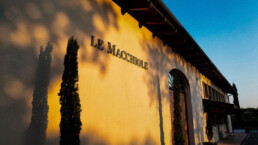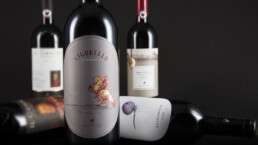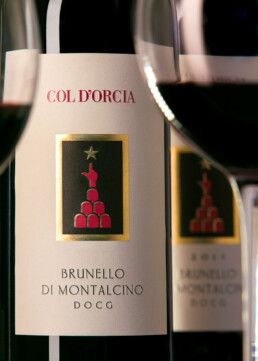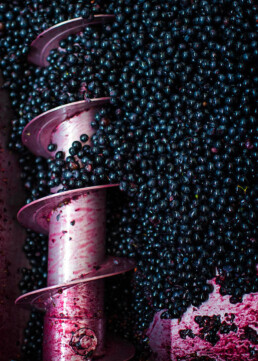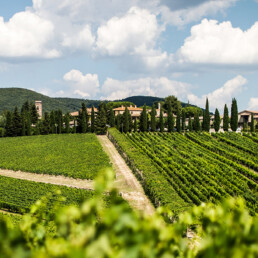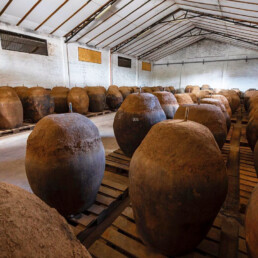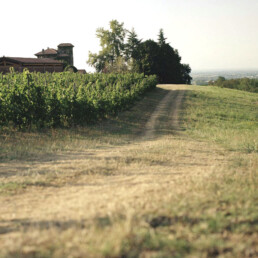Focus On: Triumphant Tuscany
"Tuscany is Tuscany. It remains the strongest beacon for the great wines of Italy around the world, and as a symbol for outstanding quality wines, it is only going to get stronger…" - James Suckling, Wine Critic
La Bella Toscana, Tuscany, is the quintessential image we all have of Italian wine country – rolling hills, olive groves, avenues of ancient cypress trees, and of course, vines, lots of vines. This is the stuff of daydreams. Not to mention the cultural cradle of the Renaissance.
In recent years Tuscan wine has enjoyed a great resurgence in quality and reputation. This rapid rise of quality has increasingly grabbed our attention here at Dhall & Nash, so we decided it was time to investigate further – to ‘Focus On’ a triumphant Tuscany.
Tuscany truly epitomizes a great Italian wine region. It’s fitting that this region’s undulating hills house some of Italy’s best-known appellations, including Brunello di Montalcino, Chianti Classico and Vino Nobile di Montepulciano, as well as Vernaccia di San Gimignano and Carmignano. Then there are the prestigious coastal vineyards, and particularly the famous ‘Super Tuscan‘ wineries around Bolgheri and Maremma.
Being Italy’s 4th most planted region in Italy with 60,000 ha of vines, it is the third-largest wine-producing region in Italy after Piedmont and the Veneto. They also hold the third-highest number of DOC/DOCG quality wines in Italy. Further, it offers a diverse selection of internationally recognised wines from both indigenous and international varieties in an array of styles. Stretching from the Tyrrhenian western coastline inland toward the Apennine Mountains, Tuscany spans multiple elevations, expositions, soil types, and climatic conditions. This is a patchwork quilt of vines and wondrous wines.
“Tuscany is like a great bottle of wine; lovingly created and carefully aged. The longer you spend contemplating its rich hues, the better it gets.” – Decanter Wine Magazine
An Intriguing History of Tuscan Wine:
Tradition and millennia of viticulture have put the region of Tuscany on every wine connoisseur’s bucket list. This is one of the most famous wine-producing regions on the planet.
From antiquity, the fruit of the vine has been highly esteemed. Grapes were first cultivated by the Etruscans way back in the 8th century BC, over 3,000 years ago. They were grown in such wide abundance that they were often sold overseas and quickly became the area’s earliest and most trusted cash crop.
The Etruscans developed the area in parallel with the Greeks, before ceding to the Romans. Along with building roads and sewers, the Romans developed the region’s viticultural potential, using wood for winemaking rather than amphorae, and passing their expertise onto their French neighbours.
With the demise of Rome in the 5th century AD, the Longobards established Lucca as the capital of what was then known as Tuscia. Florence and Siena became banking and trading hubs during the Middle Ages, with Chianti – then a white wine – first documented in the 14th century. Tuscany passed from the Medici to the Habsburgs as part of the Holy Roman Empire, and then onto the Austrian Empire before becoming part of a reunified Italy in 1861. The quality of Chianti was first recognised by the Grand Duke of Tuscany, Cosimo III, who classified its finest areas in 1716.
This was the first legal wine classification in Europe. It wasn’t until the middle of the 19th century, however, that a standard ‘recipe’ for its wine was developed by Baron Ricasoli. It was a blend of three grape varietals in strict proportions: 70% Sangiovese, 15% Canaiolo (red grape) and 15% Malvasia Bianca (white grape).
Chianti wine became so important to the Sienese economy and Florentine region that by 1903 an association was formed to protect its quality. In 1931, the boundaries of Chianti vineyards were established.
In the 1950s this system of noble landowners with sharecroppers working the land came to an end and the vineyards and wine took a downturn. By the beginning of the 1980s investors from other parts of Italy and foreigners invested in the region and modernized the facilities and vineyards moving away from some of the lackluster winemaking and introducing international varietals.
Nowadays, Chianti producers use a variety of native and international grapes in the various regional blends. Only in 1996 did it become legal to make Chianti wine with 100% Sangiovese grapes. The current decree for a DOC Chianti wine is that it must include at least 80% Sangiovese.
Obviously in the late 20th century, a few ambitious producers began working outside the Chianti regulations. Their vision for Chianti wine was for even higher quality. These ‘unclassified’ wines, such as Tignanello and Sassicaia, became nicknamed “Super Tuscans”. But we’ll get to these a bit further on…
The Big Picture of Tuscany:
Tuscany is a predominantly hilly region with vineyard elevations rising up to 550 meters above sea level. About a quarter of the landscape is mountainous and a scant 8% is officially classified as flat.
For the most part Tuscany is nirvana for wine ‘terroir-istes’ – the region has always been associated with a myriad of specific terroirs linked to unique wines. Importance of site has continued into modern times. Very broadly speaking, Montalcino and some parts of Chianti Classico have some friable marl-like soils called Galestro. Montepulciano has sand and heavy clay soils and San Gimignano has sandy soils, often over compacted clay.
The Mediterranean climate is a vital factor in this region’s success as a wine region. Warm, temperate coastal areas are contrasted by inland areas (particularly those in the rolling hills), where increased diurnal temperature variation helps to maintain the grapes’ balance of sugars, acidity, and aromatics. One variety that particularly thrives on these hillside vineyards is Tuscany’s signature red grape, Sangiovese.
Giacomo Tachis, Italian wine expert and co-creator of the celebrated Sassicaia wine, describes the Tuscan vineyards with passion. “Here there is light, the sun. Radiant sunlight and the right soil are the soul of wine. But the tradition of the countryside and the memory of men are the solid basis of the extraordinary Tuscan wine culture.”
Amazingly, there are 41 D.O.Cs and 11 D.O.C.Gs (Vino a denominazione di origine controllata e garantita) in Tuscany. There are six more flexible IGP (Indicazione Geografica Protetta) / IGT designations, but many producers often choose to use the IGT “Toscana” (Indicazione Geografica Tipica) to avoid the restrictions.
In the interests of space and not boring you to tears, for this blog we will focus on the 4 most well-known Tuscan wine subzones of: Montalcino, Chianti, Montepulciano and Bolgheri.
Without totally neglecting Tuscan whites, however, less than 20% of the wines produced in the region are white, with Trebbiano being the most widely planted variety. Vernaccia and Vermentino actually have more to offer in the quality stakes. Of course, the exquisitely picturesque be-towered hilltop village of San Gimignano has converted many white wine drinkers to its dry white Vernaccia di San Gimignano DOCG. Overall, there are some fine examples of Tuscan white wines, ranging from complex and age worthy to uncomplicated and downright deliciously quaffable.
The Many Faces of Sangiovese:
Red grapes are where it’s at in Tuscany. The hero grape in these parts is Sangiovese, a tricky variety to grow well. It needs lots of sunshine to ripen, and its thin skin makes it vulnerable to fungal diseases.
Some areas of fertile soils exacerbate this tendency to grow large berries in huge bunches, and its tannins, unless handled carefully, can be coarse. Furthermore, it’s an old variety with great genetic diversity, so good growers take particular care to ensure that they have correctly matched clone to location to get a high-quality crop.
You might wonder why Tuscan winemakers continue to struggle with such a fickle grape… but when they get Sangiovese right, it is a grape that rewards the producer with rich perfume, elegance, and silky texture. Its firm tannins and lively acidity can provide the kind of structural balance that pleases lovers of fine Italian wines. Sangiovese-based wines tend to have an earthy character and distinctive sour and black cherry flavours. The best expressions are robust and age-worthy with additional herbal, spicy, toasty, and smoky notes.
The bitter-sweet appeal of Sangiovese was perfectly expressed by the 17th century Italian poet, Fulvio Testi who wrote that it “kisses you and bites you and makes you shed sweet tears”.
Sangiovese (also known as Sangiovese Piccolo) is one of the most ancient Italian grape varieties and is certainly one of the most widely grown. All experts agree that the grape originated in Tuscany and includes two families of grapes. The first, has a grape that is sweeter and is used to make Brunello di Montalcino; the second family has a smaller grape and are stronger and rougher.
Prugnolo Gentile (also known as Sangiovese Grosso) can be traced back to the Sangioveto variety which is popular in Montepulciano and in the province of Siena. The Prugnolo Gentile/Sangiovese Grosso or “Brunello” grape is known in the areas around Montalcino and Montepulciano and is now also being cultivated in several other areas of Tuscany. Compared to the Sangiovese Piccolo, the Sangiovese Grosso has larger, more loosely bunched grapes, and thicker grape skins.
“The highest expression of Sangiovese is perhaps to be found in the southern Brunello di Montalcino zone around the town of Montalcino.” – Jancis Robinson MW, Wine Critic
Monumental Montalcino:
In terms of international renown, the Montalcino area is Tuscany’s second most important wine zone, after Chianti Classico. In terms of quality, however, it’s Tuscany’s original star.
The Montalcino region is shaped like a four-sided pyramid, whose well-sheltered, well-drained topography is bright, breezy, and especially vine friendly. Half of Montalcino’s land is wild, either grassland or oak and chestnut forests teeming with wild boar.
Sangiovese is the only grape variety permitted for Montalcino’s two flagship red wines: the under-appreciated Rosso di Montalcino DOC, which can be sold after one year of oak ageing, and the globally acclaimed Brunello di Montalcino DOCG, which ages for a minimum of two years in oak and four years overall before release.
Brunello is simply the local name for Sangiovese, used since 1865, when a producer in Montalcino made Italy’s first 100% Sangiovese wine. The region’s 250 wineries are mostly small scale – 20ha or less – and in total make up 3,500ha under vine, or about 15% of the land.
If Chianti Classico is generally best at between four and eight years, Brunello can evolve for a decade or sometimes two. The lighter (and in many ways more useful) wines of the zone are sold as Rosso di Montalcino. One of the best producers of both styles is Dhall & Nash’s very own Col d’Orcia.
Some producers are purposely creating a wine to be consumed upon release or only within a few years after – but of high quality. While others are bottling what have come to be known as ‘’aby Brunellos’ – these are Rossos that have the balance and depth to age. In the end, both versions can be fantastic. Our personal favourites are wines that straddle the best qualities of each of them.
The Modern Style of Classy Chianti:
“The number of winemakers focusing on expressing the terroir of the great villages and vineyards of the top and historic subregion of Chianti is certainly on the rise.” – James Suckling, Wine Critic
Located in the central region of Tuscany, the Chianti zone is Tuscany’s largest classified wine region and produces over eight million cases a year. The region is split into two DOCGs – Chianti and Chianti Classico. Dhall & Nash’s famed San Felice is in the heartland of Chianti Classico. The terroir of the Classico zone varies throughout the region depending on the vineyards’ altitude, soil type and distance from the Arno River. The soils of the northern communes, such as Greve, are richer in clay deposits while those in the southern communes, like Gaiole, are harder and stonier. Riserva Chianti is aged for at least 27 months, some of it in oak, and must have a minimum alcohol content of 12.5%.
No more daggy wine bottles wrapped in straw! Chianti Classico is undergoing an evolution driven by a handful of producers focused on identifying the region’s best subzones and vineyards. The current makeover of Tuscan wine is centred on a renewed emphasis on Sangiovese, thanks to new clones and selections. Quality is again improving as vineyards are not only replanted with higher density and better rootstocks, but also farmed with more precision, enhancing their ability to express differences bases on site, elevation, soil type, and geography.
The newest Gran Selezione designation was introduced in 2013, that requires estate-grown fruit only to be used. But it doesn’t require 100% Sangiovese from single vineyards as some producers had hoped. Now there is a trend toward the further delineation of subzones with common characteristics.
Click here to read more on San Felice.
“Anyone who loves Brunello should now also focus on what is happening in Chianti Classico. There were some literally jaw-dropping single-vineyard selections around like [those from…] San Felice. The wines were all awe-inspiring and the furthest cry imaginable from the red-fruited, rather mundane stereotypes of lesser Chiantis.” – James Suckling, Wine Critic
The Noble Wine of Montepulciano:
In south-eastern Tuscany in the province of Siena, the rolling hills of Montepulciano sit perched between the Ocria and the Chiana rivers. The region is synonymous with Vino Nobile di Montepulciano, a Sangiovese-based wine redolent with dark fruit like plum, cherry, and strawberry, with tannins not unlike toasty tea. It was the second red Tuscan wine to attain DOCG status in 1980. Vino Nobile di Montepulciano has a proud history dating back to the 17th century, when the local vino was dubbed “noble” because it was a favourite of noblemen. In more recent times, the producers have worked hard to maintain an elite image for their wine, in the face of stiff competition from both Chianti Classico and Brunello di Montalcino.
There is minimum oak ageing periods of just one year rather than the two required for Brunello. The minimum quotient of Sangiovese has also been lowered to 70% of the blend, allowing for more enthusiastic use of international varieties. Some would describe Vino Nobile as a sort of cross between Brunello and Chianti Classico.
Tuscany’s "New Kid on the Block" – Bolgheri DOC & The Super Tuscans:
Sangiovese shines in all the traditional subzones of Tuscany. While on the western Maremma coast in the province of Livorno, sits the exceptional Bolgheri DOC dominated by international grape varieties that gave rise to the supermodels of Italian wine – the Super Tuscans!
This was Italy’s most recent renaissance which began in Tuscany in the late 1960s, as a member of the extended Antinori family, (Marchese Mario Incisa della Rocchetta), first showed at his San Guido estate that the Bolgheri area could produce world-class Cabernet Sauvignon in the form of his Super Tuscan Sassicaia. By the 1980s, a younger Antinori, Lodovico, made his name with Ornellaia (mainly Cabernet) and Masseto (mainly Merlot), produced almost next door.
Super Tuscans were made from grape varieties (mainly red Bordeaux varieties) that were not permitted in appellation-labelled wines. Accordingly, these wines were put in the lowest classification in Italian wine law, Vino da Tavola (VDT – ‘table wine’), which included mass-produced and mediocre wines made from overcropped vines. This was a time when tradition collided fiercely with innovation in the 1970s. Change was a-foot.
Sassicaia quickly received international critical acclaim causing ripples that would change Italian labelling laws forever. This is a one-of-a-kind wine is made with Cabernet Sauvignon and a small amount of Cabernet Franc grapes. Sassicaia is often compared to the classic Bordeaux wines Lafite Rothschild and Mouton Rothschild. A collector’s dream and always featured on the wine lists of the world’s best restaurants, the 2015 Sassicaia was awarded Best Wine of the World in the 2018 Wine Spectator Magazine.
Bolgheri’s reputation continues unabated. Fortunately, this Super Tuscan success story has carried the whole of Tuscany on its coat-tails, resulting in higher quality wines across the board.
Today, Super Tuscan wines include some of the most formidable names recognized worldwide. They are expensive but worth every penny. But there are of course many affordable “baby” Super Tuscans too like the stallion in Dhall & Nash’s stable – Le Macchiole.
There’s a uniqueness to the sensational Super Tuscans in that every producer strives to create a blend that reflects their specific estate, their terroir, and therefore, an individual experience to taste. However, that can make choosing among the best Super Tuscan wines more difficult; every Super Tuscan wine is different, and the best wine for you will depend on the grape varieties you most enjoy and whether you prefer blends or varietal wines.
Essentially, Super Tuscans introduced New World inclusiveness to an Old World ideology, specifically through the willingness to adopt Bordeaux blend styles. This certainly improved the quality and added diversity to Tuscany, leaving the impression that the grapes should decide how terroir should be expressed, not the other way around.
Today, many producers still opt for a Toscana IGT status to leave their hands untied as they focus on quality and the style they want. At the very least they will have some wines bearing this lower appellation status.
Tuscan Treasures from Dhall & Nash:
“Perhaps [Tuscan] winemakers are looking more to bring out the uniqueness of where their wines come from than seek the slightly manipulated, fruit-forward styles that were favoured in the past. Today’s releases are much more about drinkability and balance.” -James Suckling, Wine Critic
Using Bordeaux grapes and innovative winemaking techniques, Le Macchiole showed how this coastal Bolgheri region has become world-class for wines that marry “almost New World character [with] savoury and wild herb notes strongly rooted in Tuscany,” explains Wine Spectator senior editor Bruce Sanderson.
Le Macchiole, founded in 1983, began as a love story. But in 2002, Cinzia Merli and her husband had just expanded their vineyard holdings and designed a new cellar when he died. But she kept on: “What has not changed is the love and the passion that we put into this job.”
Her Le Macchiole Toscana Messorio is pure Merlot, “a great variety, but it’s really sensitive,” Merli said. “You must take care of it.” And they do: Ten vineyard plots are vinified separately, half in steel and half in concrete, then aged 18 months in new oak barrels. The result is a vibrant wine with “unabashed fruit”.
2018 Le Macchiole Bolgheri Rosso:
“Aromas of currants, dried flowers and black licorice follow through to a full to medium body with medium chewy tannins and a long, fine finish. A blend of merlot, cabernet franc, cabernet sauvignon and syrah.” 93/100 points, Wine Spectator
2016 Le Macchiole Paleo:
“Made entirely with Cabernet Franc, this radiant red opens with intense aromas of black currant, Mediterranean scrub, blue flower, and camphor aromas. On the supremely elegant palate, supple tannins and bright acidity accompany cassis, black raspberry, crushed herb and licorice before a cedar finish. It’s smooth, radiant, and delicious, with great energy. Drink 2022-2037.” 97/100 points, Wine Enthusiast
2017 Le Macchiole Messorio:
“…a wine that beautifully reflects the characteristics of the vintage and is a very accurate measuring stick of how any single vintage will eventually perform both in terms of near-term accessibility and long-term cellar aging. That said, the Le Macchiole 2017 Messorio plays its strongest cards in terms of mouthfeel and texture, revealing a robust structure and firmly integrated tannins that come from both the richly concentrated fruit and the careful use of oak. The wine shows a heavy center of gravity and a solid base of dark fruit that is enhanced by caramel, brown sugar, spice, and creamy blackberry preserves. It does offer immediate appeal, but I’d wait a few more years to give this 2017 Messorio more time to flesh out and evolve.” 95/100 points, Robert Parker’s Wine Advocate (Monica Larner)
2016 / 2017 Le Macchiole Scrio:
“The 2016 Le Macchiole Scrio is a fruitier Syrah than the 2015, which was more about the pepper and the savory spice. The 2015 was broader, while this wine is more linear and classic. It boasts more depth and brings a lot of earthy tones, and it’s generally a much more vertical wine than the 2015. This is a very precise, beautiful, and detailed expression of Syrah that shows a very generous disposition overall. In fact, this wine harnesses the exuberant abundance of the grape and channels it with extreme elegance.” 96+/100 points, Robert Parker’s Wine Advocate (Monica Larner)
“The 2017 Le Macchiole Scrio is a pure expression of Syrah that shows more similarities to the variety when grown in France than it does California, Australia or even the rest of Tuscany for that matter. Instead of the peppery charred meat or barbecued aromas you often get in New World Syrah, this wine points to blackberry, some black olive, rum cake, crème de cassis or chocolate-covered cherries. Although the wine is varietally pure, it doesn’t really scream Syrah in any sort of obvious or banal manner. The tannins are more gripping in this hot vintage, and the wine spreads over the palate with a creamy, almost waxy texture that is enduring and deep.” 95/100 points, Robert Parker
Col D’Orcia in Chianti Classico DOCG
The Col d’Orcia estate is one of the oldest wine producers and began creating Italy’s most revered red wine, Brunello di Montalcino, more than 100 years ago. Since 2010, the entire Col d’Orcia estate, including vineyards, olive groves, and other fields, and even the garden, are grown exclusively by the use of organic agricultural practices. With this certification, Col d’Orcia has the largest certified organic vineyard in Tuscany – it is an “organic island” in the Montalcino region.
Organics and Biodynamics devotee, owner Francesco Marone Cinzano, seems to spend an awful lot of his time growing anything but grapes at his 550ha Col d’Orcia estate, Montalcino’s third-largest vineyard at 150ha. Spelt and durum wheat are sown across 200ha, to be used for making pasta flour, while flowering plants such as clovers and blue tansy are sown across 60ha for the estate’s 200 beehives, owned by a local honey producer. After flowering, the seeds are collected, stored, and sown in the vineyards as cover crops.
The high density of planting, the choice of the rootstock suitable for the characteristics of each piece of land, the use of highly selected clones and an overall attention to the characteristics of each single vineyard ensure a limited production per plant aimed at achieving high quality grapes, healthy, concentrated, and rich in colour and tannins. A winning formula indeed.
2012 Col d’Orcia Poggio al Vento Brunello di Montalcino Riserva:
“…a monumental wine from this storied appellation in southern Tuscany. From a warm vintage, this is a deeply textured, rich, and succulent rendition of Sangiovese. You taste the exuberant flavours of sun-drenched fruit. However, you also taste some evolution (remember, we are talking about a wine released seven years after the harvest) with tarry notes of toasted spice, liquorice, and Spanish cedar. This wine ages in large oak casks (of various sizes) for four years followed by an additional two years in bottle. We can look forward to more bottle evolution as the wine moves forward in time.” 95/100 points, Robert Parker’s Wine Advocate
2016 Col d’Orcia Brunello di Montalcino:
“Lustrous mid ruby. Savoury and a little subdued and reductive at the beginning. Wet-earth notes and sour cherry with hints of cassis. Tightly-wound, succulent cherry fruit palate that is stubbornly closed, with long, sandy tannins. The fruit is a little on the skinny side, but this is still embryonic. Long aromatic finish. Grows on you. Drink 2022 – 2032.” 17/20 points, Jancis Robinson
What’s Happening in Tuscany Today?:
Organic and biodynamic wine practices continue to trend around the world, particularly in Europe. Tuscans are among the wine producers that are increasingly embracing sustainable practices in the vineyards and the cellar. The focus on native grapes and terroir-driven wines is also on the rise, both globally and in this region.
Over the past few decades, Chianti winemakers have been shedding their reputation as producers of daggy red wine in straw-covered bottles. These days, many of the best winemakers are focused on regional typicity and terroir-driven expressions of Sangiovese and other native varieties with respect to individual sub-appellations. The future looks exciting for more compelling Tuscan wines with the X-factor!
Whatever the grape variety, indigenous or not, there’s a distinctive Tuscan taste to all the wines. That is based on something powerfully flavoured but bright, where the fruit is sweet and the tannins dry, the texture is fleshy and final impression taut. Such combinations are rare in the wine world, but prevalent in Toscana. Do your future self a favour and buy more than a few of these incredible Tuscan treasures.
Geek Talk – Italian Wine Classifications
Wouldn’t you know it, like most things in Italy where nothing is really ever cut and dry trying to decipher the intricacies of Italian wine appellations can leave your head spinning. Here we’ll try to keep it simple.
The Italian classifications: DOC and DOCG are two quality classifications, roughly equivalent to the French AC and AOC if you’re familiar with that. These regulations, set out by each area’s consortium, indicate what is permitted in terms of production area, wine colour, grape varieties and max/min proportions, styles of wine, max/min alcohol levels as well as permitted or mandated viticultural, vinification and maturation techniques. The difference between the two is that DOCG is more restrictive than DOC; DOCG labelled wines are analysed and tasted by government–licensed staff before being bottled.
The Italian system was created in 1963 and updated a few times since then to protect wine quality and region standards.
The system features four designations. Starting with the top designation and working down. Note that a wine that falls into the “lowest” designation isn’t necessarily a bad wine. It might just be a ‘rebellious’ winemaker not willing to abide by the Italian wine laws, as was the original motivation for Super Tuscans.
1) DOCG (Vino a denominazione di origine controllata e garantita) – This designation denotes the highest quality recognition for Italian wines. Wines grown in DOCG regions have a very strict set of laws, including grape varieties, maximum yield of grapes per hectare, vineyard and winemaking practices and more. This designation also requires a blind quality taste test (my next job)! In Italy, there are just over 30 DOCGs, most of them in the Piedmont and Tuscany regions.
2) DOC (Vino a denominazione di origine controllata) – This designation has slightly fewer laws than DOCG. There are over 300 DOCs in Italy.
3) IGT (Vino da tavola con indicazione geografica tipica) – This designation is for “table wines” that meet geographic and grape varietals requirements. The IGT standards are less rigid than for DOC and DOCG wines. There are close to 125 IGT areas in Italy.
4) VDT (Vino da tavola) – This is the least strict designation. It’s given to table wines that don’t have a specific geographic origin or that don’t follow current Italian wine law.
Appellations in Tuscany – Chianti, Carmignano, Vino Nobile di Montepulciano, San Gimignano, Valdichiana, Brunello di Montalcino, Bolgheri.
